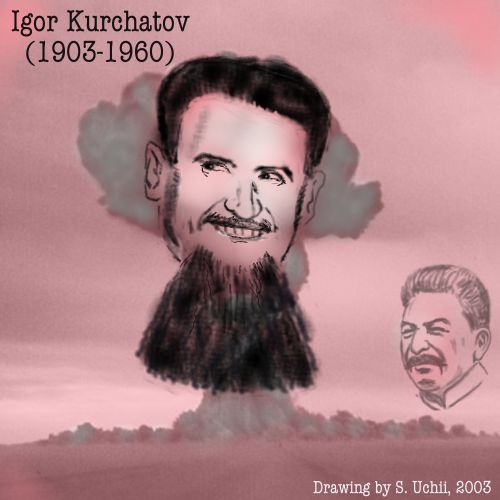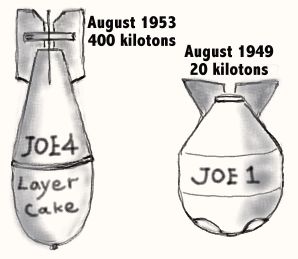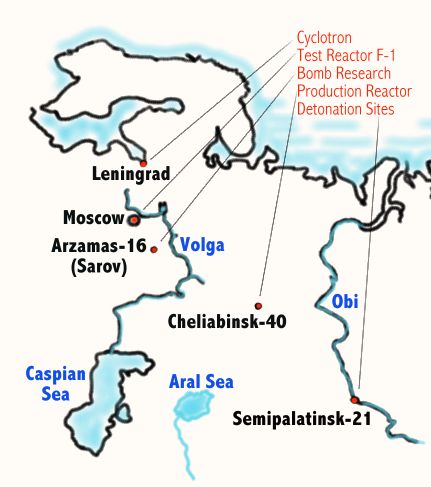| 1932 |
Abram Ioffe (1880-1960), a Russian don physicist, nominated
Igor Kurchatov as the leader of nuclear research. |
| 1934 |
The first cyclotron constructed by Kurchatov and A.
I. Alikhanov (1904-70) |
| 1935 |
"The Great Terror" began (Stalin wanted to eliminate
all people against him) |
| 1939 |
The news of nuclear fission struck Russian physicists;
Iulii Khariton (1904-1996) and I. B. Zel'dovich (1914-87) reported
their series of research. |
| 1940 |
The NKVD (People's Commissariat of Internal Affairs, the state
security organization, headed by Beria) began espionage to collect
information on nuclear research.
Nov.: Kurchatov argued for the feasibility of a nuclear reactor,
and a uranium bomb, at the 5th All-Union Conference on Nuclear Physics
in Moscow.
|
| 1941 |
June: German Army attacked the Soviet Union (and about
30 million people were killed by the end of the war!) |
| 1942 |
March: Beria reported to Stalin about the information (based on
espionage) of nuclear research in Europe and the United States.
April: Physicist G. Flerov (1913-90) wrote a letter to Stalin,
urging the research on the nuclear bomb; Stalin, consulting major
physicists, decided to accept Flerov's advice, despite the unfavorable
state of the war and economy. This enhanced the activities of espionage.
September: The Soviet govenment chose Kurchatov as the leader
of the new project of manufacturing the atomic bomb.
|
| 1943 |
February: Kurchatov's initial plan, (1) to make a reactor, and
(2) to make a fission bomb (but with almost no amount of U235 ready
yet). He did not know yet another possibility of using plutonium.
March: Based on the information (through espionage) of British
research, Kurchatov knew many things; most important is the possibility
of using plutonium.
May-July: Kurchatov examined American documents, containing those
on the Chicago reactor (constructed by Fermi). Although the information
was rather old, it must have helped greatly the Russian plan; Kurchatov
knew what to check, what to confirm.
December: Klaus Fuchs (who was a very good physicist, but leaking
to the Soviet Union important documents of the British research
on the atomic bomb) came to the United States, as a member of the
British team. Soon, he came in contact with Harry Gold who was working
as a spy for the Soviet Union.
|
| 1944 |
June: Normandy invasion by Anglo-American troops
August: Fuchs went to Los Alamos, as one of the two assistants
of Rudolf Peierls in order to help the team of the plutonium bomb,
which was in a great trouble. Thus Fuchs got involved deeply in
the crucial design of the plutonium bomb; and his contribution to
the Soviet espionage was to become the greatest. But there were
many other persons involved in the soviet espionage.
August: Another important connection existed between David Greenglass
(a mechanist at Los Alamos) and Julius Rosenberg (a spy who became
famous after the war, and executed with his wife, June 1953). Greenglass
provided the information of high-explosive lenses used in the plutonium
bomb.
August-October: Leningrad cyclotron repaired and began operation.
And a small amount of plutonium was produced.
November: The first piece of metallic uranium produced.
|
| 1945 |
February: Fuchs handed a bulk of documents to Gold; these contained
up-to-date information on plutonium bomb, including the use of high-explosive
lenses.
March: Kurchatov knew the method of implosion from the new documents
of espionage (but not Fuchs documents).
April: Kurchatov examined Fuchs documents, and suspected that the
US project is going far ahead. While Berlin was going to fall, from
Mid-April, an American team and a Soviet team indepenently rushed
to remove uranium ore from Germany; the Americans got about 1100
tons, the Soviets got about130 tons.
May: Kurchatov and Pervukhin (high official) appealed directly
to Stalin that the Soviet nuclear research was in a poor state because
of the lack of support; but Stalin did not respond, because he doubted
the credibility of the information collected by espionage.
June 2: Fuchs met Gold in Santa Fe, and handed important documents
including the detailed description of the plutonium bomb.
June 3: Gold next met David Greenglass in Alburquerque, and obtained
the documents on implosion device.
July 2: Kurchatov obtained the newest information on the plutonium
bomb (including an approximate date of the first experiment) from
an NKVD official.
July 16: The first explosion of the plutonium bomb (in New Mexico)
July 24: Truman, speaking to Stalin, alluded to "a new weapon",
at the Potsdam Conference.
August: Informed of the Hiroshima explosion, Stalin became furious;
on August 7, he nominated Beria as the Director of the bomb project.
On August 8, The Soviet declared war against Japan. In the middle
of August, Stalin ordered, "Provide us with atomic weapons
in the shortest possible time".
August 11: Smyth Report (Atomic Energy for Military Purposes)
appeared in lithoprint edition; its typeset edition appeared on
Sept. 1, but a crucial sentence was deleted. The Russian translation
appeared early in 1946.
September 19: Fuchs again met Gold in Santa Fe, and handed a report
on the plutonium bomb; the report also contained the production
rate of U235 and of plutonium at this point.
October 18: Beria received a detailed explanation of the plutonium
bomb from the Soviet intelligence. Despite all this, the Soviet
had to construct the atomic industry from almost nothing.
October-November: Peter
Kapitsa (1894-1984) wrote letters to Stalin and questioned Beria's
leadership; Kapitsa urged to pursue the Soviet's own, original way
for developing the nuclear weapon, whereas Beria insisted on manufacturing
copies of the American bomb (a surer way). Eventually, Kapitsa was
placed under house arrest for the next 8 years (he would have been
killed by Beria, were not Stalin's inhibition).
|
| 1946 |
January 25: Kurchatov met Stalin and other high officials; and
Stalin promised full support for the bomb project. The average salary
for scientists increased sharply, and Kurchatov, in particular,
was given a new elegant house on the same ground for the F-l reactor
under construction.
April: Sarov was chosen by Iurii Khariton as the site of a new
lab for the bomb project. It was later called Arzamas-16 or "Los
Arzamas", the Russian counterpart of Los Alamos.
June 14: Fuchs remained in Los Alamos until June, and in all probability,
leaked new information on the atomic bomb and also on the early
thermo-nuclear project proposed by Edward Teller, to the Soviet
Union.
July: Two Russian obervers saw the American Bikini demonstration.
Kurchatov's team began construction of the F-1 reactor (which was
quite similar to the Hanford 305 test reactor, of the United States);
this reactor began its operation in December, and began to produce
plutonium.
In the same summer, the construction of the first production reactor
began at Cheliabinsk-40; this was the Russian equivalent of the
Hanford plant. This reactor, designed by Dollezhal', was to begin
its operation two years later, in 1948.
December 25: The F-1 reactor began operation
Sometime in 1946, a report on a fusion bomb
by Zel'dovich, Khariton et al.
|
| 1947 |
April-August: Plutonium separated from uranium oxicide produced
in the F-1 reactor.
The ideological campaign against "Western culture" began.
|
| 1948 |
July: Cheliabinsk-40 reactor began to operate. Around the same
time, Lysenko obtained support from Stalin, and denounced genetics
as "bourgeois" fabrication. The Party Central Committee
claimed ultimate authority in science. This climate threatened physics
too; according to philosophers, relativity and quantum physics are
against the communist ideology. According to a story, Beria asked
Kurchatov whether quantum mechanics and relativity are "idealistic",
and Kurchatov answered, if these were rejected as such, the atomic
bomb would have to be rejected also! Holloway argues that "It
was the atomic bomb that saved the Soviet physics in 1949"
(Holloway 1994, 211).
By the summer, Zel'dovich's group had done
calculations for a specific design for the fusion bomb. Kurchatov
asked Igor
Tamm (1895-1971) for cheking this calculation and assessing
the plan. Tamm recruited A.
Sakharov (1921-1989) and others. Sakharov's First Idea, "Layer
Cake" (fission-fusion-fission reaction, by means of alternate
layers of light and heavy fuel); this replaced Zel'dovich plan.
Second Idea by V. Ginzburg, to use lithium
deuteride, which can produce tritium in the course of explosion.
After the 1949 test of the plutonium bomb, the hydrogen bomb became
a top priority. The Soviets pursued their own ideas, instead of
immitating American ideas.
|
| 1949 |
June: Plutonium hemispheres produced, and the first atomic bomb
was ready by the summer.
August 29: The first test at the site south of Semipalatinsk-21
|
| 1950 |
Spring: Tamm's group moved from
Moscow to Arzamas-16. |
| 1951 |
Teller-Ulam Configuration, multi-stage ignition (using
X-rays) devised |
| 1952 |
Nov.: Mike test (USA) |
| 1953 |
March 5: Stalin died.
June 26: Beria arrested; he was executed on December 23.
August: Kapitsa released from house arrest.
August 12: Joe 4 (Layer Cake) test, directed
by Kurchatov. It yielded 400 kilotons.
Computers introduced for calculations.
|
| 1954 |
March: US began a series of superbomb (with lithium deutride) tests
in Bikini; Bravo produced an unexpectedly large yield of 15 megatons,
and a Japanese fishery boat and Bikini inhabitants suffered from
fallout.
Spring: Third Idea, equivalent of Teller-Ulam
configuration, occurred, and Kurchatov approved of pursuing this,
in spite of the contrary order from the Party; this caused a big
trouble with high officials.
|
| 1955 |
August: Geneva conference on the peaceful uses of atomic energy;
Kurchatov directed the Soviet preparations, and the Soviet scientists
in the conference made a good impression on the western scholars,
and this occasion became the beginning of a reconstruction of the
international scientific community after a 20-year interval.
November 22: The Soviet first Super, Semipalatinsk,
yielding 1.6 megatons (even though reduced to a half). It was dropped
from a plane. A few casualties due to the test. Kurchatov was shocked
by the sight of the ground zero, and felt that this weapon must
not be allowed to be used; he deceided to retire from any further
tests.
|
| 1956 |
April: Kurchatov visited Britain with Khrushchev and
Bulganin; and he delivered a lecture on the controlled fusion research
in the Soviet Union. This made an impact on the Western scholars,
breaking the spell of secrecy. |
| Å@ |
|
![]()



